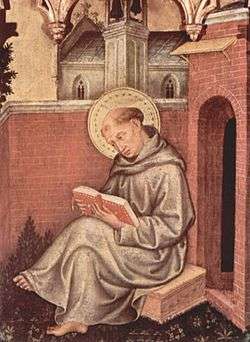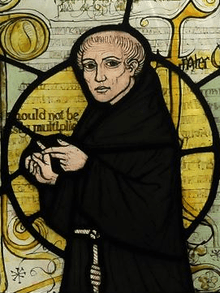Marsilio Ficino
Marsilio Ficino (Italian: [marˈsiːljo fiˈtʃiːno]; Latin name: Marsilius Ficinus; 19 October 1433 – 1 October 1499) was an Italian scholar and Catholic priest who was one of the most influential humanist philosophers of the early Italian Renaissance. He was an astrologer, a reviver of Neoplatonism in touch with the major academics of his day and the first translator of Plato's complete extant works into Latin.[1] His Florentine Academy, an attempt to revive Plato's Academy, influenced the direction and tenor of the Italian Renaissance and the development of European philosophy.
Marsilio Ficino | |
|---|---|
.jpg) Marsilio Ficino from a fresco painted by Domenico Ghirlandaio in the Tornabuoni Chapel, Santa Maria Novella, Florence | |
| Born | 19 October 1433 Figline Valdarno, Republic of Florence |
| Died | 1 October 1499 (aged 65) Careggi, Republic of Florence |
| Citizenship | Florentine |
| Period | Italian Renaissance |
| Genre | Neoplatonism |
| Notable works |
|
| Relatives | Diotifeci d'Agnolo Alessandra di Nanoccio (parents) |
| Part of a series on |
| Neoplatonism |
|---|
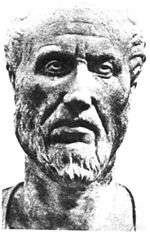 Reconstructed bust believed to represent Plotinus |
|
People
|
|
|

Biography
Ficino was born at Figline Valdarno. His father Diotifeci d'Agnolo was a physician under the patronage of Cosimo de' Medici, who took the young man into his household and became the lifelong patron of Marsilio, who was made tutor to his grandson, Lorenzo de' Medici. Giovanni Pico della Mirandola, the Italian humanist philosopher and scholar was another of his students.
During the sessions at Florence of the Council of Ferrara-Florence in 1438–1445, during the failed attempts to heal the schism of the Eastern (Orthodox) and Western (Catholic) churches, Cosimo de' Medici and his intellectual circle had made acquaintance with the Neoplatonic philosopher George Gemistos Plethon, whose discourses upon Plato and the Alexandrian mystics so fascinated the learned society of Florence that they named him the second Plato.[2] In 1459 John Argyropoulos was lecturing on Greek language and literature at Florence, and Ficino became his pupil.[2]
When Cosimo decided to refound Plato's Academy at Florence he chose Ficino as its head. In 1462, Cosimo supplied Ficino with Greek manuscripts of Plato's work, whereupon Ficino started translating the entire corpus into Latin[3] (draft translation of the dialogues finished 1468–9;[4] published 1484). Ficino also produced a translation of a collection of Hellenistic Greek documents found by Leonardo da Pistoia later called Hermetica,[5] and the writings of many of the Neoplatonists, including Porphyry, Iamblichus and Plotinus.
Among his many students was Francesco Cattani da Diacceto, who was considered by Ficino to be his successor as the head of the Florentine Platonic Academy.[6] Diacceto's student, Giovanni di Bardo Corsi, produced a short biography of Ficino in 1506.[7]
Though trained as a physician, Ficino became a priest in 1473.[8][9][10]
Work
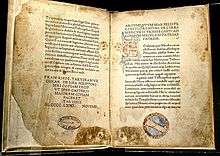
In 1474 Ficino completed his treatise on the immortality of the soul, Theologia Platonica de immortalitate animae[2] (Platonic Theology).[11] In the rush of enthusiasm for every rediscovery from Antiquity, he exhibited a great interest in the arts of astrology, which landed him in trouble with the Catholic Church. In 1489 he was accused of heresy before Pope Innocent VIII[2] and needed strong defense to preserve him from condemnation.
Writing in 1492 Ficino proclaimed: "This century, like a golden age, has restored to light the liberal arts, which were almost extinct: grammar, poetry, rhetoric, painting, sculpture, architecture, music ... this century appears to have perfected astrology."
Ficino's letters, extending over the years 1474–1494, survive and have been published. He wrote De amore (1484). De vita libri tres (Three books on life), or De triplici vita,[12] published in 1489, provides a great deal of medical and astrological advice for maintaining health and vigor, as well as espousing the Neoplatonist view of the world's ensoulment and its integration with the human soul:
There will be some men or other, superstitious and blind, who see life plain in even the lowest animals and the meanest plants, but do not see life in the heavens or the world ... Now if those little men grant life to the smallest particles of the world, what folly! what envy! neither to know that the Whole, in which 'we live and move and have our being,' is itself alive, nor to wish this to be so.[13]
One metaphor for this integrated "aliveness" is Ficino's astrology. In the Book of Life, he details the interlinks between behavior and consequence. It talks about a list of things that hold sway over a man's destiny.
Probably due to early influences from his father Diotifeci, who was a doctor to Cosimo de' Medici, Ficino published Latin and Italian treatises on medical subjects such as Consiglio contro la pestilenza (Recommendations for the treatment of the plague) and De vita libri tres (Three books on life). His medical works exerted considerable influence on Renaissance physicians such as Paracelsus, with whom he shared the perception on the unity of the micro- and macrocosmos, and their interactions, through somatic and psychological manifestations, with the aim to investigate their signatures to cure diseases. Those works, which were very popular at the time, dealt with astrological and alchemical concepts. Thus Ficino came under the suspicion of heresy; especially after the publication of the third book in 1489, which contained specific instructions on healthful living.[14]
Notably, Ficino coined the term Platonic love, which first appeared in his letter to Alamanno Donati in 1476. In 1492, Ficino published Epistulae (Epistles), which contained Platonic love letters, written in Latin, to his academic colleague and life-long friend Giovanni Cavalcanti concerning the nature of Platonic love. Importantly, Ficino's letters to Cavalcanti resulted in the popularization of the term Platonic love in Western Europe. Clement Salaman, a modern translator of Ficino’s letters, notes that, “Platonic Love has passed into common parlance as a love independent of physical attraction, a love central to Ficino’s concept of friendship.”[15] Salaman also remarks that the love to which Finico referred in his letters is "purely spiritual; it was not a polite form of words, still less a reference to homosexual love. It was a love that was all-embracing."[15] Despite the claims of modern revisionist historians, there is no evidence that Ficino was erotically attracted to men. Consistent with his life's task of reconciling Platonism with Catholicism, Ficino rejected physical expressions of love between two men as a “wicked crime.”[16] “Love and the desire for physical union,” Ficino wrote, are “not identical impulses, but…opposite ones.”[16] Further, Ficino condemned sodomy in Convivium [17][18] and faithfully adhered to the precepts of Catholic moral teaching regarding sexuality. [19][20][21]
Death
Ficino died on 1 October 1499 at Careggi. In 1521 his memory was honored with a bust sculpted by Andrea Ferrucci, which is located in the south side of the nave in the Cathedral of Santa Maria del Fiore.
Publications
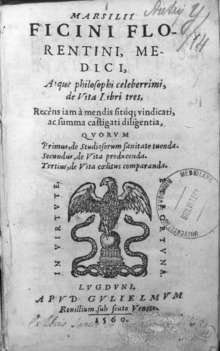
- Theologia Platonica de immortalitate animae (Platonic Theology). Harvard University Press, Latin with English translation.
- vol. I, 2001. ISBN 0-674-00345-4
- vol. II, 2002. ISBN 0-674-00764-6
- vol. III, 2003. ISBN 0-674-01065-5
- vol. IV, 2004. ISBN 0-674-01482-0
- vol. V, 2005. ISBN 0-674-01719-6
- vol. VI with index, 2006. ISBN 0-674-01986-5
- The Letters of Marsilio Ficino. Shepheard-Walwyn Publishers. English translation with extensive notes; the Language Department of the School of Economic Science.
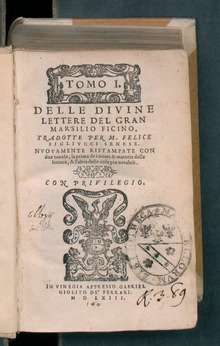
- vol. I, 1975. ISBN 978-0-85683-010-5
- vol. II, 1978. ISBN 978-0-85683-036-5
- vol. III, 1981. ISBN 978-0-85683-045-7
- vol. IV, 1988. ISBN 978-0-85683-070-9
- vol. V, 1994. ISBN 978-0-85683-129-4
- vol. VI, 1999. ISBN 978-0-85683-167-6
- vol. VII, 2003 ISBN 978-0-85683-192-8
- vol. VIII, 2010 ISBN 978-0-85683-242-0
- vol. IX, 2013 ISBN 978-0-85683-289-5
- Commentaries on Plato. I Tatti Renaissance Library. Bilingual, annotated English/Latin editions of Ficino's commentaries on the works of Plato.
- vol. I, 2008, Phaedrus, and Ion, tr. by Michael J. B. Allen, ISBN 0-674-03119-9
- vol. II, 2012, Parmenides, part I, tr. by Maude Vanhaelen, ISBN 0-674-06471-2
- vol. III, 2012, Parmenides, part II, tr. by Maude Vanhaelen, ISBN 0-674-06472-0
- Icastes. Marsilio Ficino's Interpretation of Plato's Sophist, edited and translated by Michael J. B. Allen, Berkeley: University of California Press, 1989.
- De vita libri tres (Three Books on Life, 1489) translated by Carol V. Kaske and John R. Clarke, Tempe, Arizona: The Renaissance Society of America, 2002. With notes, commentaries and Latin text on facing pages. ISBN 0-86698-041-5
- "De triplici vita". World Digital Library (in Latin). 16 September 1489. Retrieved 1 March 2014.
- De religione Christiana et fidei pietate (1475–6), dedicated to Lorenzo de' Medici.
- In Epistolas Pauli commentaria, Marsilii Ficini Epistolae (Venice, 1491; Florence, 1497).
- Meditations on the Soul: Selected letters of Marsilio Ficino, tr. by the Language Department of the School of Economic Science, London. Rochester, Vermont: Inner Traditions International, 1996. ISBN 0-89281-658-9. Note for instance, letter 31: A man is not rightly formed who does not delight in harmony, pp. 5–60; letter 9: One can have patience without religion, pp. 16–18; Medicine heals the body, music the spirit, theology the soul, pp. 63–64; letter 77: The good will rule over the stars, p. 166.
- Commentary on Plato's Symposium on Love, tr. by Sears Jayne. Spring Publications, 2nd edition, 2000. ISBN 0-88214-601-7
- Collected works: Opera (Florence,1491, Venice, 1516, Basel, 1561).
See also
References
- Marsilio Ficino. Voss, Angela. Berkeley, Calif.: North Atlantic Books. 2006. pp. ix–x. ISBN 1556435606. OCLC 65407018.CS1 maint: others (link)
- Symonds, John Addington (1911). . In Chisholm, Hugh (ed.). Encyclopædia Britannica. 10 (11th ed.). Cambridge University Press. pp. 317–319.
- Bartlett, K. R., ed. (2011). The Civilization of the Italian Renaissance: A Sourcebook. University of Toronto Press. ISBN 978-1442604858.
- Hankins, J. (1990). Plato in the Italian Renaissance. p. 300. ISBN 9004091610.
- Yates, Frances A. (1964) Giordano Bruno and the Hermetic Tradition. University of Chicago Press 1991 edition: ISBN 0-226-95007-7
- Marsilio Ficino, entry by Christopher Celenza in the Stanford Encyclopedia of Philosophy
- Annotated English translation of Corsi's biography of Ficino Archived 15 October 2011 at the Wayback Machine
- Christiane L. Joost-Gaugier, Pythagoras and Renaissance Europe: Finding Heaven, Cambridge University Press, 2009.
- Oskar, Kristeller Paul. Studies in Renaissance thought and letters. IV. Roma: Edizioni di Storia e letteratura, 1996: 565.
- "Three Books on Life". World Digital Library. 26 February 2014. Retrieved 1 March 2014.
- Deitz, Luc; Kraye, Jill (1997). "Marsilio Ficino". Cambridge Translations of Renaissance Philosophical Texts. pp. 147–155. doi:10.1017/CBO9780511803048.014. ISBN 9780511803048.
- Daniel Pickering Walker (January 2000). Spiritual and Demonic Magic: From Ficino to Campanella. Penn State Press. p. 3. ISBN 0-271-02045-8.
- Marsilio Ficino, Three Books on Life, translated by Carol V. Kaske and John R. Clark, Tempe AZ: The Renaissance Society of America, 2002. From the Apologia, p. 399. (The internal quote is from Acts 17:28.)
- Marsilio Ficino. Biography and introduction to The Letters of Marsilio Ficino, Volume 1 Archived 22 July 2014 at the Wayback Machine 1975 Fellowship of the School of Economic Science, London. Retrieved 26 April 2014.
- "Ficino Letters". www.wordtrade.com. Retrieved 13 May 2020.
- Crompton, Louis (2003). Homosexuality & Civilization. Cambridge, Massachusetts: The Belknap Press of Havard University. p. 269.
- Giovanni Dall'Orto, Socratic love as a disguise for same sex love in the Italian Renaissance, Journal of Homosexuality, 16
- G. Hekma (ed), The pursuit of sodomy: male homosexuality in the renaissance and enlightenment, Haworth Press, 1989
- Giovanni Dall'Orto, Socratic love as a disguise for same sex love in the Italian Renaissance, Journal of Homosexuality, 16
- G. Hekma (ed), The pursuit of sodomy: male homosexuality in the renaissance and enlightenment, Haworth Press, 1989
- Chapters 3 and 4 in Todd W. Reeser, Setting Plato Straight: Translating Ancient Sexuality in the Renaissance. Chicago: UChicagoP, 2016.
Further reading
- Allen, Michael J.B.; Rees, V.; Davies, Martin (2002). Marsilio Ficino: his theology, his philosophy, his legacy. BRILL. ISBN 9789004118553. Retrieved 26 May 2013.
- Allen, Michael J. B., Nuptial Arithmetic: Marsilio Ficino's Commentary on the Fatal Number in Book VIII of Plato's Republic. Berkeley: University of California Press, 1994. ISBN 0-520-08143-9
- Ernst Cassirer, Paul Oskar Kristeller, John Herman Randall, Jr., The Renaissance Philosophy of Man. The University of Chicago Press (Chicago, 1948.) Marsilio Ficino, Five Questions Concerning the Mind, pp. 193–214.
- Clucas, Stephen; Forshaw, Peter J.; Rees, Valery (2011). Laus Platonici Philosophi: Marsilio Ficino and his Influence. BRILL. ISBN 9789004188976. Archived from the original on 5 October 2016. Retrieved 8 September 2014.
- Anthony Gottlieb, The Dream of Reason: A History of Western Philosophy from the Greeks to the Renaissance (Penguin, London, 2001) ISBN 0-14-025274-6
- James Heiser, Prisci Theologi and the Hermetic Reformation in the Fifteenth Century (Repristination Press, Malone, Texas, 2011) ISBN 978-1-4610-9382-4
- Paul Oskar Kristeller, Eight Philosophers of the Italian Renaissance. Stanford University Press (Stanford California, 1964) Chapter 3, "Ficino," pp. 37–53.
- Raffini, Christine, "Marsilio Ficino, Pietro Bembo, Baldassare Castiglione: Philosophical, Aesthetic, and Political Approaches in Renaissance Platonism", Renaissance and Baroque Studies and Texts, v.21, Peter Lang Publishing, 1998. ISBN 0-8204-3023-4
- Robb, Nesca A., Neoplatonism of the Italian Renaissance, New York: Octagon Books, Inc., 1968.
- Reeser, Todd W. Setting Plato Straight: Translating Ancient Sexuality in the Renaissance. Chicago: UChicagoP, 2016.
- Field, Arthur, The Origins of the Platonic Academy of Florence, New Jersey: Princeton, 1988.
- Allen, Michael J.B., and Valery Rees, with Martin Davies, eds. Marsilio Ficino : His Theology, His Philosophy, His Legacy.Leiden : E.J.Brill, 2002. A wide range of new essays.ISBN 9004118551
- Voss, Angela, Marsilio Ficino, Western Esoteric Masters series. North Atlantic Books, 2006. ISBN 978-1-5564-35607
External links
| Wikiquote has quotations related to: Marsilio Ficino |
| Wikimedia Commons has media related to Marsilio Ficino. |
- Works by Marsilio Ficino at Open Library
- Platonis Opera Omnia (Latin)
- Celenza, Christopher S. "Marsilio Ficino". In Zalta, Edward N. (ed.). Stanford Encyclopedia of Philosophy.
- Marsilio Ficino at the Mathematics Genealogy Project
- Marsilio Ficino entry by James G. Snyder in Internet Encyclopedia of Philosophy
- Short Biography of Ficino
- Catholic Encyclopedia entry
- The Influence of Marsilio Ficino
- www.ficino.it Website of the International Ficino Society
- Online Galleries, History of Science Collections, University of Oklahoma Libraries. High resolution images of works by and/or portraits of Marsilio Ficino in .jpg and .tiff format.

